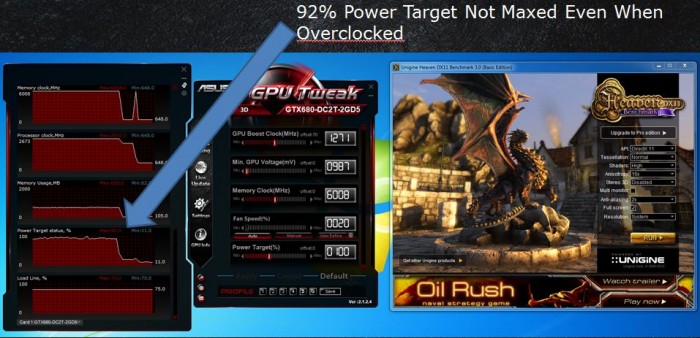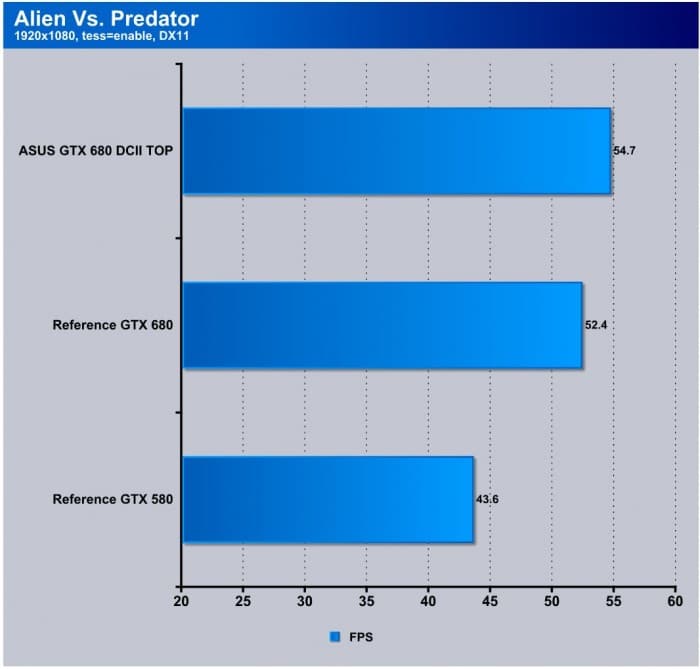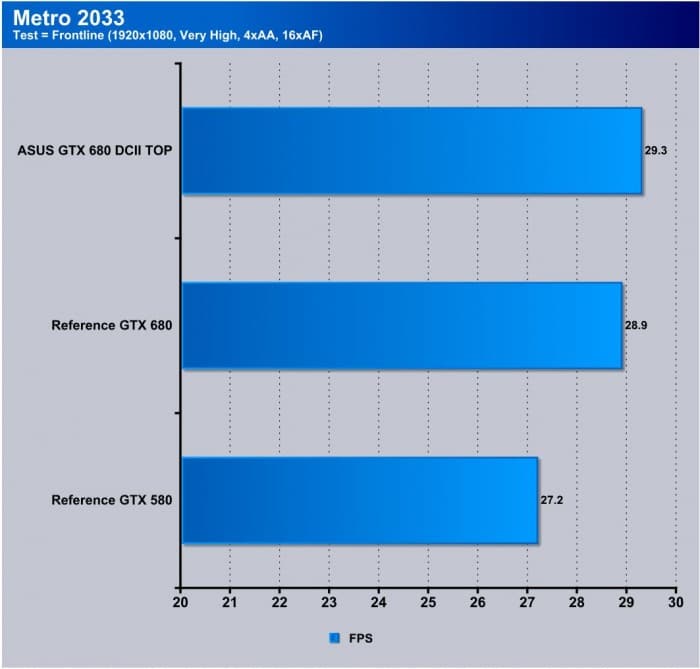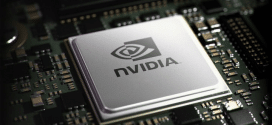ASUS GTX680 Direct CU II TOP
Testing & Methodology
We’ve expanded our testing suite considerably since the X79 chipset release, and will continue to use the same methods for most of the motherboards and CPU’s we test. In the interests of thoroughness and accurate results, we run each test at least three times, and some tests more than that. We average the total of all the tests from each benchmark then report the average here.
The OS we use is Windows 7 Pro 64bit with all patches and updates applied. We also use the latest drivers available for the motherboard and any devices attached to the computer. We do not disable background tasks or tweak the OS or system in any way. We turn off drive indexing and daily defragging. We also turn off Prefetch and Superfetch. This is not an attempt to produce bigger benchmark numbers. Drive indexing and defragging can interfere with testing and produce confusing numbers. If a test were to be run while a drive was being indexed or defragged, and then the same test was later run when these processes were off, the two results would be contradictory and erroneous. As we cannot control when defragging and indexing occur precisely enough to guarantee that they won’t interfere with testing, we opt to disable the features entirely.
Prefetch tries to predict what users will load the next time they boot the machine by caching the relevant files and storing them for later use. We want to learn how the program runs without any of the files being cached, and we disable it so that each test run we do not have to clear Prefetch to get accurate numbers. Lastly we disable Superfetch. Superfetch loads often-used programs into the memory. It is one of the reasons that Windows occupies so much memory. Vista fills the memory in an attempt to predict what users will load. Having one test run with files cached, and another test run with the files un-cached would result in inaccurate numbers. Again, since we can’t control its timings so precisely, it we turn it off. Because these four features can potentially interfere with benchmarking, and and are out of our control, we disable them. We do not disable anything else.
We are revamping our testing method in order to better represent motherboard performance and offering to the consumer. Also we want to make it an easier read for you without miles of endless charts. We ask that you provide feedback in an effort to help us deliver better reviews for you.
Test Rig
| Test Rig | |
| Case | Thermaltake Level 10 GT |
| CPU | Intel Core i7-3770K/Intel Core i7-2600K |
| Motherboard | ASUS Maximus V Gene |
| Ram | 16GbpsB Patriot Viper Xtreme 2400MHz + |
| CPU Cooler | Swiftech H20-220 Edge |
| Hard Drive | Western Digital Velociraptor 300GB |
| SSD | Intel 510 series SATA III 120GB |
| Optical | ASUS BD-ROM |
| GPU | ASUS GTX680 DCII TOP / Reference Nvidia GTX680 / Reference Nvidia GTX580 |
| Additional Cards |
N/A |
| PSU | Thermaltake Toughpower Grand 1200W |
| Mouse | Tt eSPORTS Black gaming mouse |
| Keyboard | Tt eSPORTS Meka G1 mechanical gaming keyboard |
Test Suite
We will use the following applications to test the performance of the graphics card.
Synthetic Benchmarks & Games
| Benchmarks |
|---|
| 3DMark11 |
| Aliens vs. Predator |
| Batman: Arkham City |
| Dirt 3 |
| Metro 2033 |
Overclocking
The GTX 680 and all Kepler cards have a completely different way of referencing clockspeeds as they now overclock via offsets and this takes some getting used to but once you do these cards can really ramp. For this sample we got the GTX680 DCII TOP to just over 1370 MHz at 1372 with full stability and this was from a base clock out of the box of 1137MHz and with a mild voltage increase while still maintaining more than acceptable temps. With a 100Mv increase we really don’t see that causing any excessive degradation or enough heat to cause issues so we would feel safe running this clock 24/7 for gaming without issues. Memory clocked very well to as it started out of the box at 6008MHz and shot up to just about 6500MHz at a final stable clock of 6496MHz.
This is not the tell all for every model as this was the sample we recieved and cards do vary from one another. You could easily receive one that overclocks better or worse than ours, but we’re guessing it won’t be too far off.
One thing to note is that when overvolting these cards now days via the software the Kepler cards have whats referenced as a “Power target” which means that at 100% power target normally Nvidia cards will have a limit at that power target but the target can be adjusted by offsets within the GPU Tweak software for more headroom. that being said we also can note that even overclocked the GPU never reaches the normal 100% power target which speaks very much to teh efficiency of the VRM DIGI+ design and the overall overclocking headroom that is available on the card itself. Granted there is a certain thermal envelope and overall relistic max you can expect before having to go cold but with these special features built into the card it certainly helps you stretch its legs just a little more when you really wanna push it.
As seen the card can be overclocked without touching the voltage tuning which in turn means you dont have to go crazy with the voltage or pump up the target to the absolute limit just to get some sweet overclocks whereas the reference card you definitely had to give it some love to get to this level.
In order to ensure no system bottleneck we clocked the CPU to 4.6GHz to ensure there is no reason the system will slow down the cards performance at all.
Some may ask why we chose the mainstream Z77 system and we can explain. Up until recent the X79 enthusiasts platform does not really support PCIe Gen 3 on the Nvidia 600 series GPU’s and come to find out it is due to the inherent instability many have seen with the X79 platform with Gen 3 products. This is why Nvidia has been hesitant to enable it, and now there is a workaround via registry to get it working but in order to ensure best possible testing scenarios we have stuck to the natively supported Z77 platform.
Important note: Overclocking can cause component failure. Please exercise caution when attempting any level of overclock on system components.
Temperatures
The temperatures were recorded with full loaded Heaven benchmark looping for over 30 minutes or longer depending how long it took for the card to level out in temps and sat at a plateau for more than 10 minutes.
| GPU Temperatures | Temperature (Idle/Load) |
| ASUS GTX680 DCII TOP OC | 32C/71C |
| ASUS GTX680 DCII TOP | 32C/69C |
The cooling efficiency of the cooler can be seen as it keeps the card nice and cool not to mention during the runs it was very quiet and in no way annoying at all.
Real world/Gaming Benchmarks
3DMARK 11
3DMark 11 is the newest in Futuremark’s suite of benchmarking utilities. Its a fully capable DirectX11 benchmark which also stresses and analyzes the system performance as a whole to simulate a heavy rendering environment such as a high end game or other app the end user may run. This benchmark was run with Performance settings 5 times and all runs were averaged for the result below.
Here we see the 680 is quite a jump over teh 580 of old and the TOP card with its extra clock is just that much better knocking out another 2 FPS on the Graphics test.
Aliens Vs Predator
Aliens Vs Predator is a quite demanding game and overall just a cool title so we had some fun running this one through its paces.
Here we see the jump from 580 to 680 is pretty drastic, then we go to the TOP and the jump is small but still apparent. This looks like the 680 itself runs the game much better than 580 but overclocking it will only net negligible gains.
Metro 2033
Metro 2033 is just pure hell on a GPU as with the GTX580 we found minimum framerates slowing to a complete crawl, though with the new GTX 680 that situation has been improved by a bit. The TOP card adds a small amount more of performance but Metro 2033 still shows itself as a very hard nut to crack as it looks like Dual 680’s would do the job but at max settings there could still be some stutter from a single GPU setup.
Batman: Arkham City
Batman is a very cool game once again, it is one I personally enjoy and benchmarking it shows that once again it is a game that likes the Kepler cards alot and shows a sizable jump from the 580 to 680. Then add the TOP and all of the sudden we get a nice little jump from the higher clockspeeds.
Dirt 3
Dirt 3 is a relatively newer game to me and I must say it is first of all it is a pretty good looking game but it doesnt seem to tax a GPU too bad which is good for midrange gamers. In the case of 580 vs 680 there is a sizable 60+FPS jump then another 25FPS jump from the higher clocked TOP card which means this game just loves GPU frequency.
 Bjorn3D.com Bjorn3d.com – Satisfying Your Daily Tech Cravings Since 1996
Bjorn3D.com Bjorn3d.com – Satisfying Your Daily Tech Cravings Since 1996


















